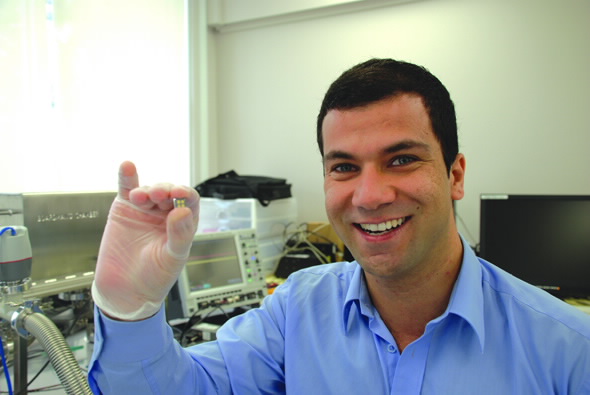In a world first, Australian scientists have designed and developed a miniature radiation detector the size of a human cell nucleus.
 |
| The revolutionary device called a micro-dosimeter can accurately measure how much energy is deposited by radiation in the cell nucleus. |
The revolutionary device called a micro-dosimeter can accurately measure how much energy is deposited by radiation in the cell nucleus which greatly assists in the understanding of the effect of the radiation on the cell.
As Richard Branson gears up to commercialise flights into space, a team of Australian scientists are pushing new frontiers that could not only make air and space travel safer but also help in the fight against cancer.
The technology was developed in collaboration between the University of Wollongong, ANSTO and the University of New South Wales based on an original concept from Professor Anatoly Rozenfeld of the University of Wollongong.
"This is a significant breakthrough in our ability to successfully measure different kinds of radiation and accurately predict the cancer risk of radiation exposure," said Anatoly.
Anatoly explained that conventional detectors are not sophisticated enough to give accurate readings as they are only designed to measure radiation in large volumes and only for specific types of radiation, namely gamma and neutron.
To build a micro-dosimeter, the volume of a cell nucleus, unique nanofabrication techniques were employed at the Nanotechnology Fabrication Facility at the University of New South Wales.
"This new technology has significant potential on two important fronts - for air and space travel where the radiation field is complex, (containing many different particle types) and for better understanding the radiation dose people receive during cancer treatments, like proton therapy," he said.
While proton therapy is still not available in Australia, it is an emerging cancer treatment that is more accurate in dose delivery, and hence reduces side effects. Proton interaction is more complex than conventional radiotherapy. The new micro-dosimeter is helping to understand the differences in these types of radiation.
While developmental testing of the technology was conducted at ANSTO making use of the organisation's heavy-ion particle accelerator, the work of the collaborative team has caught the attention of various international research scientists.
Dr Mark Reinhard, who is a research leader at ANSTO, explained the micro-dosimeter was tested in the Massachusetts Hospital, USA. They placed the micro-chips in a 'human phantom' - and measured the energy deposited in regions the size of a human cell nucleus.
"These findings will enable radiation oncologists to more accurately deliver proton treatments to fight cancer cells," Mark said.
The micro-dosimeter is also being investigated by the NASA space program as one of the major barriers for space travel is cosmic radiation. This type of radiation is so varied and intense that astronauts can suffer serious problems from exposure during space missions.
With funding from the US-based National Space Biomedical Research Institute (NSBRI) the micro-dosimeter was launched on board a US Naval Academy satellite in March 2007 to investigate how it could play a part in protecting astronauts from space radiation. The University of Wollongong and the ANSTO research team are expected to conduct further tests with NSBRI in the near future.
While space travel for most people might seem like light years away, air travel is very real. Most commercial flights travel at about 30,000 feet and radiation is variable with a mixture of gamma, neutron and heavy ion.
Having this type of sophisticated monitoring equipment is important to further ensure travel safety - especially as we go into the future where people like Richard Branson will be taking people into space where ionising radiation levels can vary widely and cancer risk needs to be measured.
Further testing of the micro-dosimeter to monitor modelled aviation radiation fields is due to commence shortly in CERN, the world's largest particle physics laboratory in Switzerland.
And for the future, the collaboration sees the micro-dosimeter getting even smaller! The team is now investigating new types of materials for fabricating devices that are the size of human DNA.
"We know that radiation can penetrate right through the human body and can break strands of DNA, the software of life that resides inside a cell nucleus. If we can model the effects of radiation on DNA level with the new radiation detectors then we are at the crest of countless possibilities," Mark concluded.
Published: 03/03/2008

